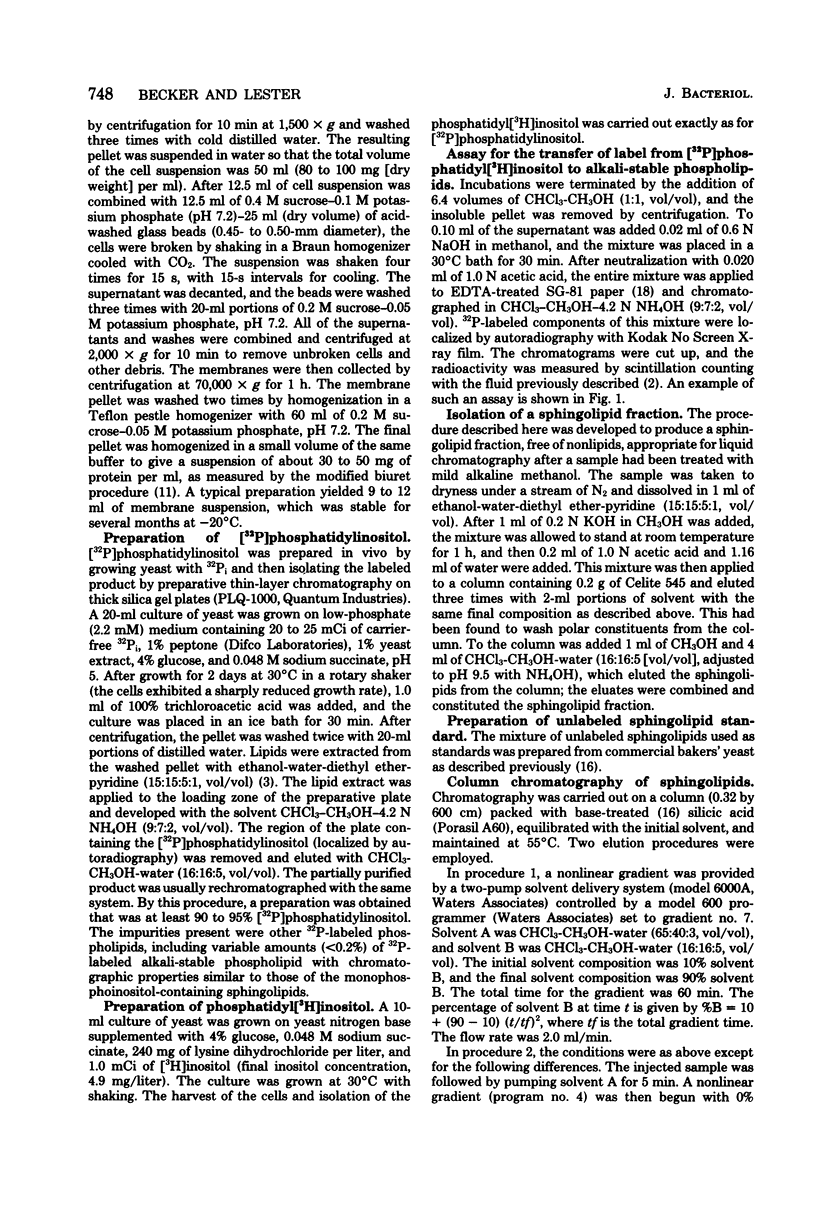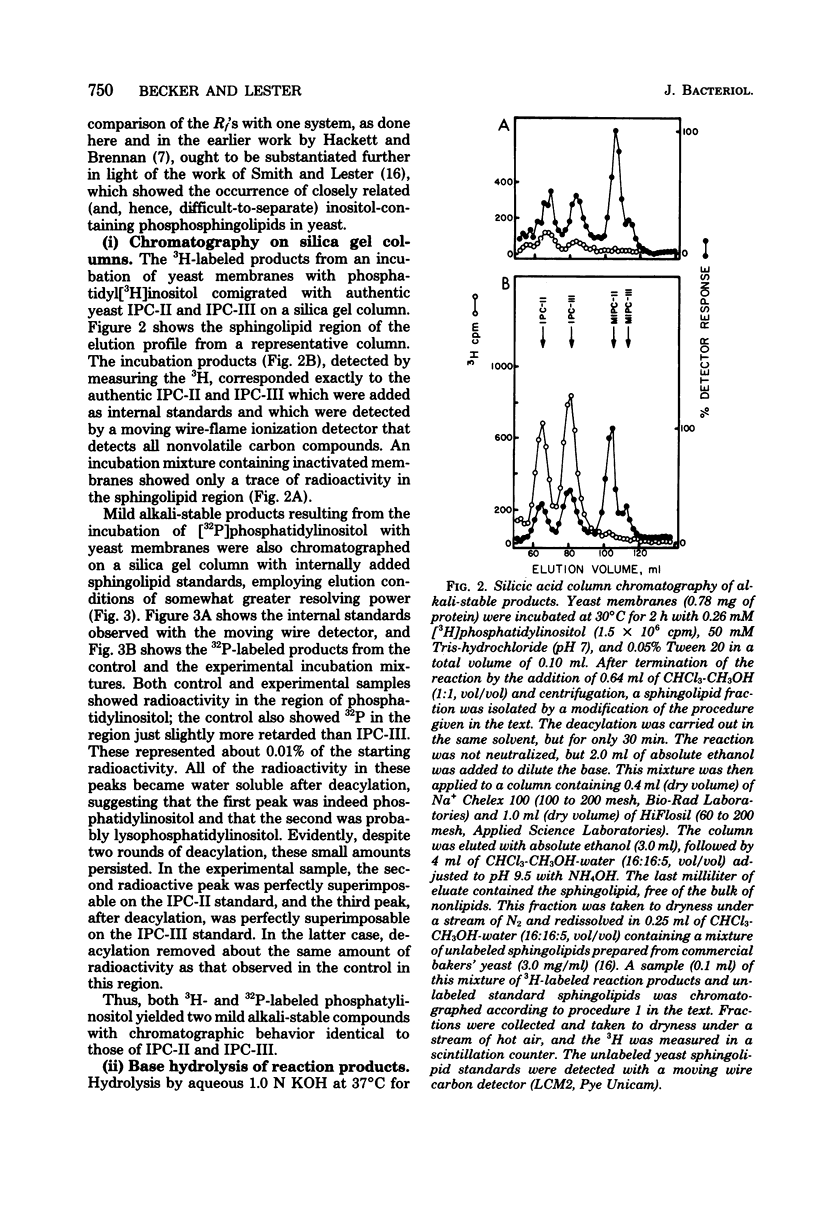Abstract
Incubation of membranes prepared from Saccharomyces cerevisiae with [32P]phosphatidyl[3H]inositol resulted in the transfer of both labels to two products which were characterized as two species of inositolphosphoceramide, differing in the ceramide portion of the molecule. The products were characterized on the basis of stability in mild alkali, mobility on silica gel-impregnated paper, chromatography on silicic acid columns, and release of inositol phosphate upon base hydrolysis. The reaction did not require the addition of metals, nor was it inhibited by ethylenediaminetetraacetic acid. The detergents Triton X-100 and Tween 20 provided little, if any, stimulation. At relatively high concentrations of phosphatidylinositol (1 to 4 mM), the in vitro rate was about 20% of the in vivo rate. Although ceramide was a logical substrate, the reaction could not be greatly stimulated by the addition of ceramides containing mono- and dihydroxy fatty acids. In addition, incubation of yeast membranes with [32P]phosphatidylinositol gave rise to a product that was chromatographically indistinguishable from the major yeast phosphosphingolipid, mannose-(inositol-P)2 ceramide.
Full text
PDF







Images in this article
Selected References
These references are in PubMed. This may not be the complete list of references from this article.
- Angus W. W., Lester R. L. The regulated catabolism of endogenous and exogenous phosphatidylinositol by Saccharomyces cerevisiae leading to extracellular glycerophosphorylinositol and inositol. J Biol Chem. 1975 Jan 10;250(1):22–30. [PubMed] [Google Scholar]
- Angus W. W., Lester R. L. Turnover of inositol and phosphorus containing lipids in Saccharomyces cerevisiae; extracellular accumulation of glycerophosphorylinositol derived from phosphatidylinositol. Arch Biochem Biophys. 1972 Aug;151(2):483–495. doi: 10.1016/0003-9861(72)90525-5. [DOI] [PubMed] [Google Scholar]
- Becker G. W., Lester R. L. Changes in phospholipids of Saccharomyces cerevisiae associated with inositol-less death. J Biol Chem. 1977 Dec 10;252(23):8684–8691. [PubMed] [Google Scholar]
- Brennan P. J., Lösel D. M. Physiology of fungal lipids: selected topics. Adv Microb Physiol. 1978;17:47–179. doi: 10.1016/s0065-2911(08)60057-0. [DOI] [PubMed] [Google Scholar]
- Brennan P. J., Roe J. The occurrence of a phosphorylated glycosphingolipid in Aspergillus niger. Biochem J. 1975 Apr;147(1):179–180. doi: 10.1042/bj1470179. [DOI] [PMC free article] [PubMed] [Google Scholar]
- CARTER H. E., JOHNSON P., WEBER E. J. GLYCOLIPIDS. Annu Rev Biochem. 1965;34:109–142. doi: 10.1146/annurev.bi.34.070165.000545. [DOI] [PubMed] [Google Scholar]
- HAWTHORNE J. N. Phosphoinositides. 1. Configuration of the inositol phosphate in liver phosphatidylinositol. Biochem J. 1960 Jun;75:495–500. doi: 10.1042/bj0750495. [DOI] [PMC free article] [PubMed] [Google Scholar]
- Hackett J. A., Brennan P. J. The isolation and biosynthesis of the ceramide-phosphoinositol of Aspergillus niger. FEBS Lett. 1977 Mar 1;74(2):259–263. doi: 10.1016/0014-5793(77)80859-4. [DOI] [PubMed] [Google Scholar]
- Hsieh T. C., Kaul K., Laine R. A., Lester R. L. Structure of a major glycophosphoceramide from tobacco leaves, PSL-I: 2-deoxy-2-acetamido-D-glucopyranosyl(alpha1 leads to 4)-D-glucuronopyranosyl(alpha1 leads to 2)myoinositol-1-O-phosphoceramide. Biochemistry. 1978 Aug 22;17(17):3575–3581. doi: 10.1021/bi00610a024. [DOI] [PubMed] [Google Scholar]
- Kaul K., Lester R. L. Characterization of Inositol-containing Phosphosphingolipids from Tobacco Leaves: Isolation and Identification of Two Novel, Major Lipids: N-Acetylglucosamidoglucuronidoinositol Phosphorylceramide and Glucosamidoglucuronidoinositol Phosphorylceramide. Plant Physiol. 1975 Jan;55(1):120–129. doi: 10.1104/pp.55.1.120. [DOI] [PMC free article] [PubMed] [Google Scholar]
- Lester R. L., Smith S. W., Wells G. B., Rees D. C., Angus W. W. The isolation and partial characterization of two novel sphingolipids from Neurospora crassa: di(inositolphosphoryl)ceramide and ((gal)3glu)ceramide. J Biol Chem. 1974 Jun 10;249(11):3388–3394. [PubMed] [Google Scholar]
- PAULUS H., KENNEDY E. P. The enzymatic synthesis of inositol monophosphatide. J Biol Chem. 1960 May;235:1303–1311. [PubMed] [Google Scholar]
- Schneider E. G., Kennedy E. P. Isolation and characterization of the liponucleotides of Saccharomyces cerevisiae. Biochim Biophys Acta. 1976 Aug 23;441(2):294–301. doi: 10.1016/0005-2760(76)90172-7. [DOI] [PubMed] [Google Scholar]
- Smith S. W., Lester R. L. Inositol phosphorylceramide, a novel substance and the chief member of a major group of yeast sphingolipids containing a single inositol phosphate. J Biol Chem. 1974 Jun 10;249(11):3395–3405. [PubMed] [Google Scholar]
- Steiner M. R., Lester R. L. In vitro studies of phospholipid biosynthesis in Saccharomyces cerevisiae. Biochim Biophys Acta. 1972 Feb 21;260(2):222–243. doi: 10.1016/0005-2760(72)90035-5. [DOI] [PubMed] [Google Scholar]
- Steiner S., Lester R. L. Studies on the diversity of inositol-containing yeast phospholipids: incorporation of 2-deoxyglucose into lipid. J Bacteriol. 1972 Jan;109(1):81–88. doi: 10.1128/jb.109.1.81-88.1972. [DOI] [PMC free article] [PubMed] [Google Scholar]
- Steiner S., Smith S., Waechter C. J., Lester R. L. Isolation and partial characterization of a major inositol-containing lipid in baker's yeast, mannosyl-diinositol, diphosphoryl-ceramide. Proc Natl Acad Sci U S A. 1969 Nov;64(3):1042–1048. doi: 10.1073/pnas.64.3.1042. [DOI] [PMC free article] [PubMed] [Google Scholar]
- Waechter C. J., Steiner M. R., Lester R. L. Regulation of phosphatidylcholine biosynthesis by the methylation pathway in Saccharomyces cerevisiae. J Biol Chem. 1969 Jun 25;244(12):3419–3422. [PubMed] [Google Scholar]



